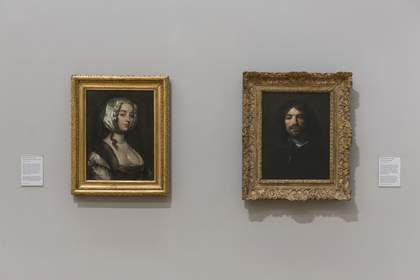For Tate press requests, email pressoffice@tate.org.uk
To download press images, visit this Dropbox folder
About Tate Britain
Tate Britain is home to the world’s greatest collection of British art. The gallery’s free displays feature over 800 works by over 350 artists, telling an expansive and diverse story which spans from the 1500s to the present day. Tate Britain welcomes over a million visitors each year to its ever-changing programme of exhibitions, commissions and events. It celebrates key figures in art history and provides a vital platform for the best artists working in Britain today, including through the Turner Prize, Art Now, and the Tate Britain Commission.
tate.org.uk/visit/tate-britain
Maria Balshaw, Director of Tate, said: “In many ways William Dobson was Britain’s answer to Rembrandt. He imbued his subjects with a profound psychological depth, never more so than in this powerful self-portrait. Tate and the National Portrait Gallery have wanted to bring this work into public ownership for decades and I’m delighted that we have finally been able to do so. This extraordinary piece of British heritage has now been saved for future generations to enjoy for free.”
About The National Portrait Gallery
Founded in 1856, the National Portrait Gallery tells the story of Britain through portraits, using art to bring history to life and explore living today. From global icons, to unsung heroes, our Collection is filled with the stories that have shaped, and continue to shape a nation. We celebrate the power of portraiture and offer encounters with some of the world’s greatest and most exciting new artists, promoting engagement with portraiture in all media to a wide-ranging public by conserving, growing and sharing the world’s largest collection of portraits.
npg.org.uk
Victoria Siddall, Director of the National Portrait Gallery, said: “We are delighted to have brought this wonderful self-portrait by William Dobson into the collection, and to have collaborated with Tate to ensure that the work is saved for the nation. This is thanks to the support of The National Lottery Heritage Fund and National Lottery players, Art Fund and a number of very generous individuals. This work is a vital part of the history of portraiture and is also one of only two works to have survived from the beginning of Dobson's career, so we are thrilled to be able to share it with audiences in London and around the country.”
About The National Lottery Heritage Fund
Our vision is for heritage to be valued, cared for and sustained for everyone, now and in the future. That’s why as the largest funder for the UK’s heritage we are dedicated to supporting projects that connect people and communities to heritage, as set out in our strategic plan, Heritage 2033. Heritage can be anything from the past that people value and want to pass on to future generations. We believe in the power of heritage to ignite the imagination, offer joy and inspiration, and to build pride in place and connection to the past. Over the next 10 years, we aim to invest £3.6billion raised for good causes by National Lottery players to make a decisive difference for people, places and communities.
heritagefund.org.uk
Follow @HeritageFundUK on Twitter/X, Facebook and Instagram and use #NationalLottery #HeritageFund
Eilish McGuinness, Chief Executive of The National Lottery Heritage Fund said: “This self-portrait by William Dobson is truly significant, as a rare painting it will now be part of the national collection and protected forever. The painting has been saved for the public by the public, thanks to money raised by National Lottery players, and fittingly will now be shared with art lovers across the UK when it goes on tour. At the Heritage Fund, our ambition is to connect people and communities to the UK’s remarkable heritage and this was always at the heart of the vision for this masterpiece’s long-term future.”
About Art Fund
Art Fund is the national charity for museums and galleries. For over 120 years, it has helped institutions across the UK to develop and share their collections, invest in people and expertise, grow their audiences and inspire the next generation. Art Fund connects museums and people with great art and culture through funding, advocacy and initiatives, because access to art is vital for a healthy society. It champions the sector through the prestigious Art Fund Museum of the Year award - the world’s largest museum prize - and supports museum professionals through dedicated training and grant programmes. Independent and people-powered, Art Fund is supported by 142,000 members who buy a National Art Pass, as well as generous contributions from individuals, trusts and foundations. The National Art Pass offers free or discounted entry to hundreds of museums, galleries and historic places in the UK, 50% off major exhibitions, a subscription to Art Quarterly magazine and Art In Your Inbox newsletter.
artfund.org
Jenny Waldman, Director, Art Fund, said: “This is a landmark acquisition: a rare self-portrait by one of Britain’s first great painters, now saved for the nation and made accessible to all. William Dobson’s work offers a window into 17th-century Britain, and it’s a triumph to see this exceptional painting secured through the collective efforts of funders, generous individuals and two of our celebrated national museums. We are proud that Art Fund’s support has helped to ensure the work can be enjoyed by the public for generations to come.”

